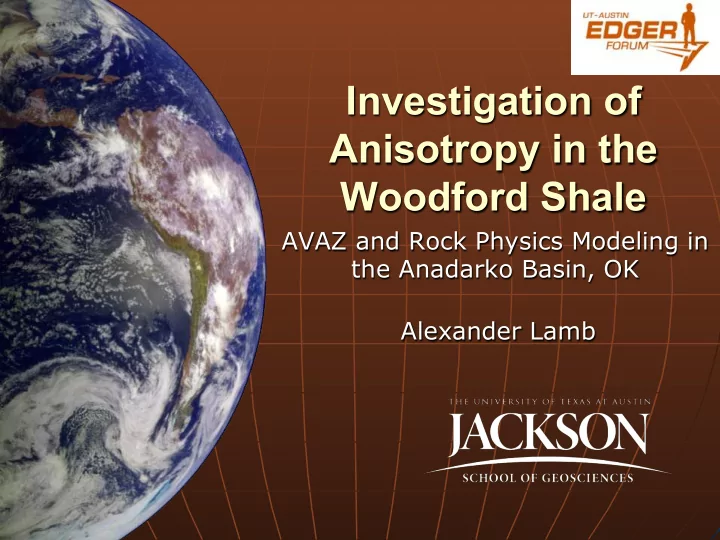

Investigation of Anisotropy in the Woodford Shale AVAZ and Rock Physics Modeling in the Anadarko Basin, OK Alexander Lamb
Outline • Background • Well Log Observations • Seismic Data Observations • Rock Physics Modeling • Synthetic Seismic Data • Results / Conclusions
Background • Woodford Shale Formation • Anadarko Basin • Canadian County, OK
Background • Woodford Shale § “Black” shale § Late Devonian / Early Mississippian § ~13,000 ft. deep § ~250 ft. thick • Mississippian Limestone above • Hunton Limestone below
Well Log Data
Anisotropy VTI HTI [from Tatham et al., 1992]
Well Log Data – VTI?
Well Log Data • Well Log Observations indicate VTI • Considerations § Higher frequency of log data (2-10kHz) § Limited resolution • What does seismic data tell us?
Seismic Data - AVAZ • Amplitude varying with azimuth • Does AVO response change as a function of azimuth? • Necessary to use pre-stack data • Key indicator of HTI
Seismic Data - Workflow • Tie well log to seismic data • Interpret Woodford horizon • Gather seismic data by azimuth (10 degree sections) • Convert from offset gathers to angle gathers • Calculate AVO gradient (B) as a function of azimuth
Seismic Data - Workflow Gather Seismic Data Convert offset gathers into angle into Azimuthal (10 gathers (from Hampson-Russell) degree) sections
Quantifying AVO • RC ( θ ) = A + B sin 2 θ
Quantifying AVO • RC ( θ ) = A + B sin 2 θ
AVAZ Results • Interpret B as a function of azimuth
AVAZ Results AVO Gradient as a Function of Azimuth 1.5 1.0 0.5 AVO Gradient 0.0 -0.5 -1.0 -1.5 -2.0
AVAZ Results • Graph results of B on polar plot • Fit ellipse to data • Minor axis points to orientation • Minor/major axis ratio indicates fracture density
AVAZ Results • Graph results of B on polar plot • Fit ellipse to data • Minor axis points to orientation • Minor/major axis ratio indicates fracture density
Seismic Data • Seismic Observations indicate HTI • Longer wavelengths ‘sample’ more rock, better for volumetric properties • Relative fracture density from AVAZ • Quantify fracture density?
Rock Physics - Workflow • Composite Estimate § Created from well log data • Hashin-Shtrikman-Walpole Bounds § Introduce Porosity • Hudson Cracked Media Model § Introduce fractures • Brown and Karringa Fluid Saturation § Add fluids
Rock Physics - Composition
Rock Physics Minerals Introduced Φ K 0, µ 0 K 1, µ 1 HSW bounds • From composition, created isotropic model of Woodford • Hashin-Shtrikman-Walpole bounds show effect of porosity ( Φ ) on stiffnesses (K, µ) • New density-porosity used
Rock Physics Introduced Φ Introduced cracks K 1, µ 1 C ij dry Hudson Model • Porous media inserted into Hudson Cracked Media Model • Specific crack density and aspect ratio used • Crack density governed by • Stiffness tensor C ij dry returned
Rock Physics BK Fluid Introduced cracks Introduced fluid Saturation C ij dry C ij • Cracked model inserted into Brown and Karringa fluid saturation method • Fluid determined by water/gas mixture governed by S w log • Stiffness tensor C ij returned
Rock Physics - Recap • Composite Estimate § Created from well log data • Hashin-Shtrikman-Walpole Bounds § Introduce Porosity • Hudson Cracked Media Model § Introduce fractures • Brown and Karringa Fluid Saturation § Add fluids • Result: C ij
Synthetic Seismic Data • From rock physics model: C ij • ANIVEC software generates synthetics • In progress: Perform AVAZ on synthetics to determine relationship between ellipticity and crack density
Results / Conclusions • Well log data indicates VTI • Seismic data indicates HTI • Preliminary AVAZ results from seismic data show a SW/NE orientation • Rock physics model based on well log data generates full stiffness tensor usable for synthetics
Future Work • Establish quantified relationship between crack density and ellipticity • Regional map of fracture orientation from AVAZ methods on seismic data • Quantify effect of varying lithology
Special Thanks to our Sponsors
Questions? Thanks for listening!
Recommend
More recommend